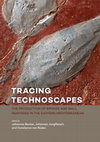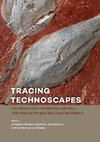Papers by Johannes Jungfleisch
In 2015 and 2016, the European 'migration crisis' saw the active involvement of journalists, scho... more In 2015 and 2016, the European 'migration crisis' saw the active involvement of journalists, scholars, and activists in documenting the border repression that characterized migratory journeys on the continent. Iconic images come to mind, such as people arriving by inflatable dinghies and living in makeshift camps, alongside the deployment of increasingly complex bordering infrastructures. Over time, these images have gradually faded, and media attention has shifted from the Mediterranean to other crises.
Lay-out & cover design: Sidestone Press Photograph cover: Detail of Fragment F00001 from Tell el-... more Lay-out & cover design: Sidestone Press Photograph cover: Detail of Fragment F00001 from Tell el-Dab c a (by Johannes Becker) ISBN 978-90-8890-687-9 (softcover) ISBN 978-90-8890-688-6 (hardcover) ISBN 978-90-8890-689-3 (PDF e-book)

Tracing Technoscapes. The Production of Bronze Age Wall Paintings in the Eastern Mediterranean, 2018
The fragmented and dislocated nature of many wall paintings obscures their former architectural c... more The fragmented and dislocated nature of many wall paintings obscures their former architectural context. As an integral part of architecture, painted plaster forms both an aesthetic and protective surface of buildings, by covering brickwork, masonry and other construction materials.
In consequence of this material entanglement, collapsed plaster provides information on once hidden and now bygone architectural features in the form of impressions on their reverse. Additionally, an inverted perspective on murals allows us to examine the practical knowledge and technical choices underlying the construction process and the practice of plastering.
In this sense, the analysis of reverse sides opens new perspectives on buildings, showing influences from different architectural traditions as attested for the palatial complex of the 18th dynasty in Tell el-Dab'a/Egypt. The use of an ‘Aegean’-style plaster technique within local-specific élite buildings represents in and of itself a new architec- tural creation. In order to specify this unique mixture, this paper discusses the reverses of the lime plaster fragments from ‘Palace G’ and ‘Palace F’ at Tell el-Dab'a with special reference to the local mud brick architecture. Furthermore, the methodological value of this approach for the reconstruction of large-scale murals will be evaluated and demonstrated here in regard to the painted architectural simulations from ‘Palace G’
Jeffrey Spier, Timothy Potts, Sara E. Cole (eds.), Beyond the Nile (Los Angeles: J. Paul Getty Museum, 2018) 56-58, 2018
This paper aims at a first reevaluation of the largely very tiny wall painting fragments found in... more This paper aims at a first reevaluation of the largely very tiny wall painting fragments found in different contexts in Hattusha. Due to their similarities to the techniques and iconographies of other Eastern Mediterranean wall painting corpora, they were mostly studied under a perspective, which almost exclusively focused on Hattusha’s external relations, particularly to the Aegean. We therefore aim to change this prospect and explore possible traces of a special local implementation of this craft and iconography. Moreover, the question why these paintings might have been desired in the Hittite capital will be elucidated.
Ethnographisch Archaologische Zeitschrift, 2006
Other by Johannes Jungfleisch
In 2015 and 2016, the European 'migration crisis' saw the active involvement of journalists, scho... more In 2015 and 2016, the European 'migration crisis' saw the active involvement of journalists, scholars, and activists in documenting the border repression that characterized migratory journeys on the continent. Iconic images come to mind, such as people arriving by inflatable dinghies and living in makeshift camps, alongside the deployment of increasingly complex bordering infrastructures. Over time, these images have gradually faded, and media attention has shifted from the Mediterranean to other crises.
Colourful surface treatments form an integral element of vernacular and élite architecture of anc... more Colourful surface treatments form an integral element of vernacular and élite architecture of ancient societies. The iconography of ancient murals provides modern beholders with information about past realities as well as interconnections between different visual systems.
Books by Johannes Jungfleisch

https://www.sidestone.com/books/tracing-technoscapes
Colourful surface treatments form an inte... more https://www.sidestone.com/books/tracing-technoscapes
Colourful surface treatments form an integral element of vernacular and élite architecture of ancient societies. This is also true for the various regions of the Eastern Mediterranean in the 2nd millennium B.C.E., where elaborate wall paintings furnished temples, tombs, palatial buildings, and in general more elaborate houses. From a present-day perspective, these rich images provide invaluable insights into past realities as well as interconnections between different visual systems. However, beyond stunning images, the materiality of wall paintings implicates a whole range of specific technical choices and gestures executed during the artistic process. The bodies of knowledge immanent in the practice of plaster and pigment preparation, in the application of paint and in the conception and execution of compositions allow us to compare the wall painting corpora of the Eastern Mediterranean on a technical level and to trace differences and similarities in a cross-cultural perspective.
Evolved from an interdisciplinary workshop held at the 10th ICAANE in Vienna, this volume provides insights into the various technical approaches and underlying bodies of knowledge in the different wall painting traditions of the Eastern Mediterranean and West Asia and throws light on the way and extent of their possible interwovenness. Moreover, it seeks to overcome regional as well as disciplinary isolation of technical studies by bringing together authors of different scientific backgrounds ranging between Conservational Studies, Archaeometry, Prehistory, Egyptology, as well as Western Asiatic and Classical Archaeology. In doing so, the book permits an interdisciplinary perspective on this field of study.
This book is equally intended for archaeologists, art historians, conservators and the interested layperson and hopes to stimulate more research in this direction in future.











Uploads
Papers by Johannes Jungfleisch
In consequence of this material entanglement, collapsed plaster provides information on once hidden and now bygone architectural features in the form of impressions on their reverse. Additionally, an inverted perspective on murals allows us to examine the practical knowledge and technical choices underlying the construction process and the practice of plastering.
In this sense, the analysis of reverse sides opens new perspectives on buildings, showing influences from different architectural traditions as attested for the palatial complex of the 18th dynasty in Tell el-Dab'a/Egypt. The use of an ‘Aegean’-style plaster technique within local-specific élite buildings represents in and of itself a new architec- tural creation. In order to specify this unique mixture, this paper discusses the reverses of the lime plaster fragments from ‘Palace G’ and ‘Palace F’ at Tell el-Dab'a with special reference to the local mud brick architecture. Furthermore, the methodological value of this approach for the reconstruction of large-scale murals will be evaluated and demonstrated here in regard to the painted architectural simulations from ‘Palace G’
Other by Johannes Jungfleisch
Books by Johannes Jungfleisch
Colourful surface treatments form an integral element of vernacular and élite architecture of ancient societies. This is also true for the various regions of the Eastern Mediterranean in the 2nd millennium B.C.E., where elaborate wall paintings furnished temples, tombs, palatial buildings, and in general more elaborate houses. From a present-day perspective, these rich images provide invaluable insights into past realities as well as interconnections between different visual systems. However, beyond stunning images, the materiality of wall paintings implicates a whole range of specific technical choices and gestures executed during the artistic process. The bodies of knowledge immanent in the practice of plaster and pigment preparation, in the application of paint and in the conception and execution of compositions allow us to compare the wall painting corpora of the Eastern Mediterranean on a technical level and to trace differences and similarities in a cross-cultural perspective.
Evolved from an interdisciplinary workshop held at the 10th ICAANE in Vienna, this volume provides insights into the various technical approaches and underlying bodies of knowledge in the different wall painting traditions of the Eastern Mediterranean and West Asia and throws light on the way and extent of their possible interwovenness. Moreover, it seeks to overcome regional as well as disciplinary isolation of technical studies by bringing together authors of different scientific backgrounds ranging between Conservational Studies, Archaeometry, Prehistory, Egyptology, as well as Western Asiatic and Classical Archaeology. In doing so, the book permits an interdisciplinary perspective on this field of study.
This book is equally intended for archaeologists, art historians, conservators and the interested layperson and hopes to stimulate more research in this direction in future.
In consequence of this material entanglement, collapsed plaster provides information on once hidden and now bygone architectural features in the form of impressions on their reverse. Additionally, an inverted perspective on murals allows us to examine the practical knowledge and technical choices underlying the construction process and the practice of plastering.
In this sense, the analysis of reverse sides opens new perspectives on buildings, showing influences from different architectural traditions as attested for the palatial complex of the 18th dynasty in Tell el-Dab'a/Egypt. The use of an ‘Aegean’-style plaster technique within local-specific élite buildings represents in and of itself a new architec- tural creation. In order to specify this unique mixture, this paper discusses the reverses of the lime plaster fragments from ‘Palace G’ and ‘Palace F’ at Tell el-Dab'a with special reference to the local mud brick architecture. Furthermore, the methodological value of this approach for the reconstruction of large-scale murals will be evaluated and demonstrated here in regard to the painted architectural simulations from ‘Palace G’
Colourful surface treatments form an integral element of vernacular and élite architecture of ancient societies. This is also true for the various regions of the Eastern Mediterranean in the 2nd millennium B.C.E., where elaborate wall paintings furnished temples, tombs, palatial buildings, and in general more elaborate houses. From a present-day perspective, these rich images provide invaluable insights into past realities as well as interconnections between different visual systems. However, beyond stunning images, the materiality of wall paintings implicates a whole range of specific technical choices and gestures executed during the artistic process. The bodies of knowledge immanent in the practice of plaster and pigment preparation, in the application of paint and in the conception and execution of compositions allow us to compare the wall painting corpora of the Eastern Mediterranean on a technical level and to trace differences and similarities in a cross-cultural perspective.
Evolved from an interdisciplinary workshop held at the 10th ICAANE in Vienna, this volume provides insights into the various technical approaches and underlying bodies of knowledge in the different wall painting traditions of the Eastern Mediterranean and West Asia and throws light on the way and extent of their possible interwovenness. Moreover, it seeks to overcome regional as well as disciplinary isolation of technical studies by bringing together authors of different scientific backgrounds ranging between Conservational Studies, Archaeometry, Prehistory, Egyptology, as well as Western Asiatic and Classical Archaeology. In doing so, the book permits an interdisciplinary perspective on this field of study.
This book is equally intended for archaeologists, art historians, conservators and the interested layperson and hopes to stimulate more research in this direction in future.